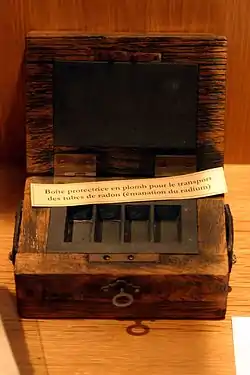Musée Curie
The Musée Curie (Curie Museum) is a historical museum focusing on radiological research. It is located in the 5th arrondissement at 1, rue Pierre et Marie Curie, Paris, France, and open Wednesday to Saturday, from 1pm to 5pm; admission is free. The museum was renovated in 2012, thanks to a donation from Ève Curie.


The museum was established in 1934, after Curie's death, on the ground floor of the Curie Pavilion of the Institut du Radium. It was formerly Marie Curie's laboratory, built 1911–1914, and where she performed research from 1914–1934. In this laboratory her daughter and son-in-law Irène and Frédéric Joliot-Curie discovered artificial radioactivity, for which they received the 1935 Nobel Prize for Chemistry.
The museum contains a permanent historical exhibition on radioactivity and its applications, notably in medicine, focusing primarily on the Curies, and displays some of the most important research apparatus used before 1940. It also contains a center for historical resource which holds archives, photographs, and documentation on the Curies, Joliot-Curies, the Institut Curie, and the history of radioactivity and oncology.